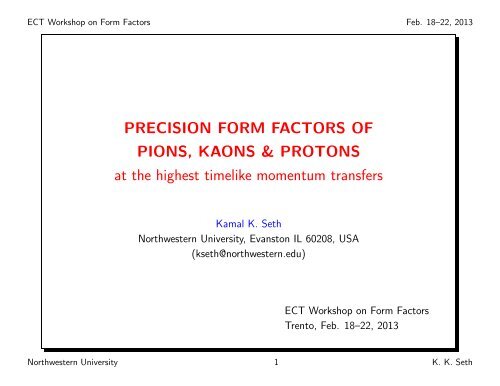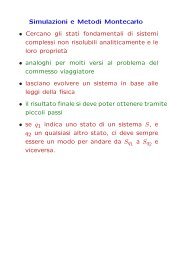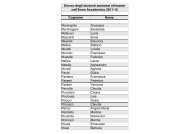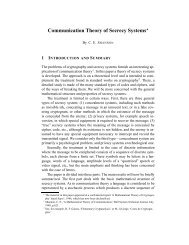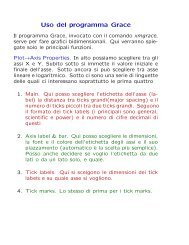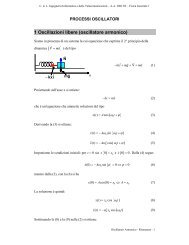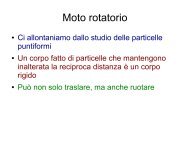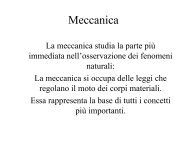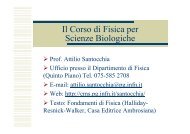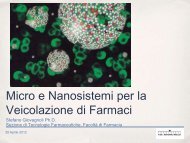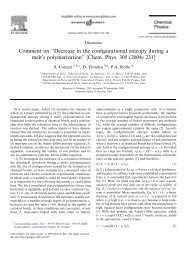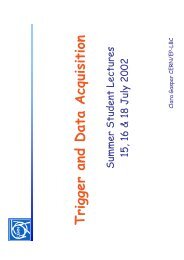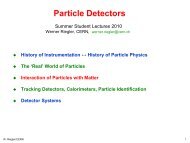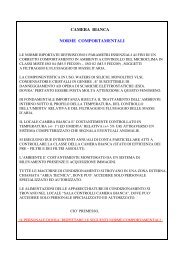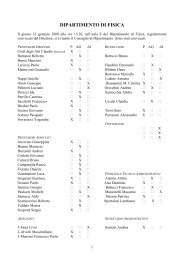New results for the form factors of Pion, Kaon, and Proton at ... - Fisica
New results for the form factors of Pion, Kaon, and Proton at ... - Fisica
New results for the form factors of Pion, Kaon, and Proton at ... - Fisica
Create successful ePaper yourself
Turn your PDF publications into a flip-book with our unique Google optimized e-Paper software.
ECT Workshop on Form Factors Feb. 18–22, 2013<br />
PRECISION FORM FACTORS OF<br />
PIONS, KAONS & PROTONS<br />
<strong>at</strong> <strong>the</strong> highest timelike momentum transfers<br />
Kamal K. Seth<br />
Northwestern University, Evanston IL 60208, USA<br />
(kseth@northwestern.edu)<br />
ECT Workshop on Form Factors<br />
Trento, Feb. 18–22, 2013<br />
Northwestern University 1 K. K. Seth
ECT Workshop on Form Factors Feb. 18–22, 2013<br />
PREAMBLE<br />
This workshop on <strong>for</strong>m <strong>factors</strong> is largely devoted to nucleon <strong>for</strong>m <strong>factors</strong>.<br />
• And <strong>the</strong>re is good reason <strong>for</strong> it.<br />
Despite <strong>the</strong> obvious bias <strong>of</strong> DeBeers <strong>for</strong> diamonds,<br />
ONLY PROTONS ARE FOREVER<br />
And nucleons do make up nearly all <strong>of</strong> <strong>the</strong> Universe!<br />
So, I will mention our <strong>results</strong> <strong>for</strong> protons, but <strong>the</strong> emphasis in my talk will be on<br />
pions <strong>and</strong> kaons.<br />
• And <strong>the</strong>re are good reasons <strong>for</strong> it too.<br />
Mesons, with only two quarks <strong>and</strong> no spin, are (or should be) hell–<strong>of</strong>–a lot simpler<br />
to underst<strong>and</strong> than baryons with three quarks!<br />
And easier wins over harder, anytime.<br />
Northwestern University 2 K. K. Seth
ECT Workshop on Form Factors Feb. 18–22, 2013<br />
PRELIMINARIES<br />
You have already heard about <strong>the</strong>se preliminary consider<strong>at</strong>ions about <strong>for</strong>m <strong>factors</strong> from<br />
previous speakers, Diego Bettoni, Rinaldo Baldini, <strong>and</strong> Frank Maas.<br />
1. Four momentum transfers defined as<br />
Q 2 (4 mom.) 2 = Q 2 (3 mom.) 2 space −(energy)2 time<br />
can be positive <strong>and</strong> spacelike, or neg<strong>at</strong>ive <strong>and</strong> timelike.<br />
e -<br />
e -<br />
p 1<br />
γ *<br />
p 2<br />
h -<br />
h -<br />
p 1<br />
h + h -<br />
γ *<br />
e + e -<br />
2. Form <strong>factors</strong> are analytic functions <strong>of</strong> momentum transfer, <strong>and</strong> <strong>the</strong>re<strong>for</strong>e, á la<br />
Cauchy, <strong>for</strong> infinite momentum transfer<br />
FF(spacelike, Q 2 = ∞) = FF(timelike, Q 2 = ∞)<br />
All <strong>the</strong> l<strong>at</strong>est measurements I will talk about are based on e + e − annihil<strong>at</strong>ion <strong>at</strong> <strong>the</strong><br />
collider <strong>at</strong> Cornell with d<strong>at</strong>a taken with <strong>the</strong> CLEO-c detector<br />
e + e − → p¯p, π + π − , K + K − , K 0 SK 0 L<br />
Northwestern University 3 K. K. Seth<br />
p 2
ECT Workshop on Form Factors Feb. 18–22, 2013<br />
PROTONS<br />
I promised not to say much about protons. So, I will only present <strong>the</strong> l<strong>at</strong>est <strong>results</strong>,<br />
including our <strong>results</strong> (PRL 110, 022002 (2013)) published one month ago, <strong>and</strong> <strong>the</strong><br />
BaBar <strong>results</strong> (arXiv:1302.0055) listed two weeks ago.<br />
(|Q 4 ||G M (Q 2 )|) / μ p (GeV 4 )<br />
2.5<br />
2<br />
1.5<br />
1<br />
0.5<br />
0<br />
BABAR FNAL CLEO NU p<br />
Timelike<br />
Spacelike<br />
α S 2<br />
4 6 8 10 12 14 16 18 20<br />
|Q 2 | (GeV 2 )<br />
I want to draw your <strong>at</strong>tention to three points.<br />
1. Irrespective <strong>of</strong> some <strong>of</strong> <strong>the</strong> large error bars, it is clear th<strong>at</strong><br />
|G E /G M |<br />
FF(timelike) ≈ 2×FF(spacelike)<br />
1.5<br />
1<br />
0.5<br />
BABAR<br />
PS170<br />
2 2.25 2.5 2.75 3<br />
M pp – (GeV/c 2 )<br />
This fe<strong>at</strong>ure, first observed in Fermilab p¯p → e + e − measurements, <strong>and</strong> confirmed<br />
by CLEO measurements, is still unexplained. Diquark–quark structure <strong>of</strong> <strong>the</strong> proton<br />
remains a contender.<br />
Northwestern University 4 K. K. Seth
ECT Workshop on Form Factors Feb. 18–22, 2013<br />
(|Q 4 ||G M (Q 2 )|) / μ p (GeV 4 )<br />
2.5<br />
2<br />
1.5<br />
1<br />
0.5<br />
0<br />
BABAR FNAL CLEO NU p<br />
Timelike<br />
Spacelike<br />
α S 2<br />
4 6 8 10 12 14 16 18 20<br />
|Q 2 | (GeV 2 )<br />
|G E /G M |<br />
1.5<br />
1<br />
0.5<br />
BABAR<br />
PS170<br />
2 2.25 2.5 2.75 3<br />
M pp – (GeV/c 2 )<br />
2. The newest <strong>results</strong>, based on <strong>the</strong> CLEO-c d<strong>at</strong>a, have better than ±5% precision.<br />
They reveal a new unexplained fe<strong>at</strong>ure:<br />
|Q 4 |GM(14.2 GeV 2 ) = (0.78±0.04)|Q 4 |GM(17.4 GeV 2 )<br />
3. The newest <strong>results</strong> from BaBar show<br />
|GE/GM| = 1.48±0.17 to 1.04±0.29 <strong>for</strong> |Q 2 | = 3.5 GeV 2 −9 GeV 2<br />
The <strong>results</strong> <strong>for</strong> |Q 2 | < 4.2 GeV 2 differ completely from those <strong>of</strong> PS170 (NP B411,<br />
3 (1994)).<br />
4. BaBar has determined <strong>the</strong> asymmetry A(cosθp) = −0.025±0.014±0.003 <strong>for</strong><br />
|Q 2 | < 9 GeV 2 , showing no evidence from higher order contributions.<br />
Northwestern University 5 K. K. Seth
ECT Workshop on Form Factors Feb. 18–22, 2013<br />
Form Factors <strong>of</strong> <strong>Pion</strong>s <strong>and</strong> <strong>Kaon</strong>s<br />
Mesons with two quarks are much simpler than baryons with three quarks. For pions<br />
<strong>and</strong> kaons with spin 0, <strong>the</strong>re is an additional simplific<strong>at</strong>ion. There is no magnetic <strong>for</strong>m<br />
factor, <strong>and</strong> so, σ(e + e − → π + π − ) = (πα 2 /3s)βπ|Fπ(s)| 2 .<br />
• The classic deb<strong>at</strong>e about when |Q2 | is large enough <strong>for</strong> <strong>the</strong> validity <strong>of</strong> pQCD<br />
took place in <strong>the</strong> 1980s between Brodsky et al. <strong>and</strong> Isgur et al. Un<strong>for</strong>tun<strong>at</strong>ely, <strong>the</strong><br />
<strong>the</strong>n existing experimental d<strong>at</strong>a <strong>for</strong> pions <strong>and</strong> kaons was too poor to be <strong>of</strong> much<br />
use in settling <strong>the</strong> deb<strong>at</strong>e.<br />
|Q 2 | |F π (Q 2 )| (GeV 2 )<br />
Q 2 F π (Q 2 ) (GeV 2 )<br />
3<br />
2.5<br />
2<br />
1.5<br />
1<br />
0.5<br />
Timelike<br />
π<br />
|Q 2 | (GeV 2 0<br />
0 2 4 6 8 10 12 14<br />
)<br />
1.4<br />
1.2<br />
1<br />
0.8<br />
0.6<br />
0.4<br />
0.2<br />
0.225<br />
0.2<br />
0.175<br />
0.15<br />
0.125<br />
0.1<br />
0.075<br />
0.05<br />
0.025<br />
0<br />
0 0.05 0.1 0.15 0.2 0.25 0.3<br />
Spacelike<br />
Q 2 (GeV 2 0<br />
0 2 4 6 8 10 12 14<br />
)<br />
π<br />
|Q 2 | |F K (Q 2 )| (GeV 2 )<br />
Q 2 F K (Q 2 ) (GeV 2 )<br />
3<br />
2.5<br />
2<br />
1.5<br />
1<br />
0.5<br />
Timelike<br />
K<br />
|Q 2 | (GeV 2 0<br />
0 2 4 6 8 10 12 14<br />
)<br />
1.4<br />
1.2<br />
1<br />
0.8<br />
0.6<br />
0.4<br />
0.2<br />
0.14<br />
0.12<br />
0.1<br />
0.08<br />
0.06<br />
0.04<br />
0.02<br />
0<br />
0 0.02 0.04 0.06 0.08 0.1 0.12<br />
Spacelike<br />
K<br />
Q 2 (GeV 2 0<br />
0 2 4 6 8 10 12 14<br />
)<br />
For |Q 2 | > 5 GeV 2<br />
Up to ±100% errors<br />
D<strong>at</strong>a limited to<br />
Q 2 < 2.5 GeV 2 <strong>for</strong> π<br />
Q 2 < 0.12GeV 2 <strong>for</strong>K<br />
Northwestern University 6 K. K. Seth
ECT Workshop on Form Factors Feb. 18–22, 2013<br />
Spacelike Form Factors <strong>of</strong> <strong>Pion</strong>s <strong>and</strong> <strong>Kaon</strong>s<br />
Spacelike <strong>for</strong>m <strong>factors</strong> <strong>of</strong> mesons are very difficult to measure, because meson targets<br />
do not exist. Two different methods have been used.<br />
1. Fπ <strong>and</strong> FK from Elastic Sc<strong>at</strong>tering <strong>of</strong> pions/kaons <strong>of</strong>f <strong>at</strong>omic electrons,<br />
π(K)e − → π(K)e − . Un<strong>for</strong>tun<strong>at</strong>ely, in this approach <strong>the</strong> momentum transfer is<br />
very small. At CERN <strong>for</strong> 200 GeV pions, Q 2 (π) ≤ 0.25 GeV 2 <strong>and</strong><br />
Q 2 (K) ≤ 0.11 GeV 2 were realized.<br />
2. Fπ from Electroproduction <strong>of</strong> pions,<br />
e − p → e − π − p (e − π + n), has serious <strong>the</strong>oretical problems<br />
<strong>and</strong> uncertainties. The good precision d<strong>at</strong>a are confined<br />
to Q 2 < 2.45 GeV 2 (JLab).<br />
FK from Electroproduction <strong>of</strong> kaons — No d<strong>at</strong>a exist.<br />
• As you will see, excellent timelike <strong>for</strong>m factor d<strong>at</strong>a <strong>for</strong> π<br />
<strong>and</strong> K <strong>at</strong> large Q 2 now exist. It is a pity th<strong>at</strong> <strong>the</strong><br />
corresponding spacelike d<strong>at</strong>a do not exist to allow us to<br />
determine if <strong>the</strong> r<strong>at</strong>io <strong>of</strong> timelike/spacelike <strong>for</strong>m <strong>factors</strong><br />
<strong>for</strong> mesons is also ≈ 2, as it is <strong>for</strong> protons.<br />
Q 2 F π (GeV/c) 2<br />
e<br />
γ *<br />
F π<br />
e /<br />
π + (π - )<br />
p (n) n (p)<br />
0.8<br />
0.6<br />
0.4<br />
0.2<br />
QCD Sum Rules (Nesterenko, 1982)<br />
pQCD (Bakulev et al, 2004)<br />
BSE-DSE (Maris <strong>and</strong> T<strong>and</strong>y, 2000)<br />
Disp. Rel. (Geshkenbein, 2000)<br />
0<br />
0 0.5 1 1.5 2 2.5 3 3.5 4<br />
Northwestern University 7 K. K. Seth<br />
CERN π-e sc<strong>at</strong>tering<br />
DESY (Ackermann)<br />
DESY (Brauel)<br />
JLab (Tadevosyan)<br />
this work<br />
Q 2 (GeV/c) 2
ECT Workshop on Form Factors Feb. 18–22, 2013<br />
Measurements <strong>of</strong> <strong>Pion</strong> <strong>and</strong> <strong>Kaon</strong> Timelike Form Factors<br />
Timelike <strong>for</strong>m <strong>factors</strong> are determined by measuring <strong>the</strong> cross sections<br />
e + e − → h + h − , h = π,K,p, etc.<br />
They have <strong>the</strong> gre<strong>at</strong> advantage <strong>of</strong> being able to determine <strong>for</strong>m <strong>factors</strong> <strong>of</strong> any<br />
hadron, but <strong>the</strong>y have <strong>the</strong> gre<strong>at</strong> problem <strong>of</strong> detecting <strong>the</strong> desired hadron pair in<br />
presence <strong>of</strong> several orders <strong>of</strong> magnitude larger background <strong>of</strong> QED–produced e + e − <strong>and</strong><br />
µ + µ − pairs.<br />
• The MC–gener<strong>at</strong>ed figure shows th<strong>at</strong> <strong>for</strong> √ s = 3.77 GeV, <strong>the</strong> expected peak<br />
counts <strong>for</strong> π, K, <strong>and</strong> p range from 500 to 100 counts, whereas <strong>the</strong> peak counts <strong>for</strong><br />
electrons <strong>and</strong> muons are 10 7 <strong>and</strong> ∼ 10 6 , i.e., lepton rejection <strong>at</strong> 3 to 4 orders <strong>of</strong><br />
magnitude is required.<br />
Northwestern University 8 K. K. Seth
ECT Workshop on Form Factors Feb. 18–22, 2013<br />
Measurements <strong>of</strong> <strong>Pion</strong> <strong>and</strong> <strong>Kaon</strong> Timelike Form Factors (cont’d)<br />
I will not bore you with <strong>the</strong> nitty-gritty <strong>of</strong> how using all <strong>the</strong> detector components <strong>of</strong><br />
CLEO-c, <strong>the</strong> drift chambers, <strong>the</strong> central calorimeter, <strong>the</strong> RICH detector, <strong>and</strong> muon<br />
detector, we were able to identify π, K, <strong>and</strong> p cleanly, in presence <strong>of</strong> <strong>the</strong> monstrous<br />
backgrounds <strong>of</strong> electrons <strong>and</strong> muons. Here is how clean!<br />
Counts / 0.02<br />
Counts / 0.02<br />
Counts / 0.02<br />
180<br />
160<br />
140<br />
120<br />
s = 3772 MeV<br />
MC<br />
(a) PIONS<br />
π<br />
350<br />
300<br />
250<br />
s = 3772 MeV<br />
MC<br />
(b) KAONS<br />
K<br />
70<br />
60<br />
50<br />
s = 3772 MeV<br />
MC<br />
(c) PROTONS<br />
p<br />
100<br />
200<br />
40<br />
80<br />
150<br />
30<br />
60<br />
40<br />
100<br />
20<br />
20<br />
0<br />
120<br />
0.96<br />
μ<br />
0.98 1<br />
s = 3772 MeV<br />
1.02<br />
(d) PIONS<br />
50<br />
0<br />
1.04300<br />
0.96 0.98 1<br />
s = 3772 MeV<br />
10<br />
0<br />
1.02 1.04140<br />
0.96<br />
(e) KAONS<br />
0.98 1<br />
s = 3772 MeV<br />
1.02 1.04<br />
(f) PROTONS<br />
100<br />
250<br />
120<br />
80<br />
200<br />
100<br />
60<br />
150<br />
80<br />
60<br />
40<br />
100<br />
40<br />
20<br />
50<br />
20<br />
0<br />
0.96<br />
50<br />
0.98 1<br />
s = 4170 MeV<br />
0<br />
1.02 1.04<br />
(g) PIONS 120 0.96 0.98 1<br />
s = 4170 MeV<br />
0<br />
1.02 1.04 0.96<br />
(h) KAONS 25<br />
0.98 1<br />
s = 4170 MeV<br />
1.02 1.04<br />
(i) PROTONS<br />
40<br />
30<br />
20<br />
100<br />
80<br />
60<br />
40<br />
20<br />
15<br />
10<br />
10<br />
20<br />
5<br />
0<br />
0.96 0.98 1 1.02 1.04<br />
Xπ<br />
0<br />
40.96 0.98 1 1.02<br />
0<br />
1.044<br />
0.96 0.98 1 1.02 1.04 4<br />
X<br />
X<br />
Xh ≡ [E(h + )+E(h − )]/ √ s<br />
K<br />
p<br />
3.77 GeV—MC<br />
3.77 GeV—D<strong>at</strong>a<br />
4.17 GeV—D<strong>at</strong>a<br />
Northwestern University 9 K. K. Seth
ECT Workshop on Form Factors Feb. 18–22, 2013<br />
|Q 2 | |F π (Q 2 )| (GeV 2 )<br />
3<br />
2.5<br />
2<br />
1.5<br />
1<br />
0.5<br />
L<strong>at</strong>est <strong>Pion</strong> <strong>and</strong> <strong>Kaon</strong> Timelike Form Factors<br />
(PRL 95, 261803 (2005)) (PRL 110, 022002 (2013)))<br />
BABAR CLEO Present π<br />
QCDSR<br />
J/ψ<br />
pQCD<br />
α S<br />
AdS/QCD<br />
0<br />
0 2.5 5 7.5 10 12.5 15 17.5 20<br />
|Q 2 | (GeV 2 )<br />
|Q 2 | |F K (Q 2 )| (GeV 2 )<br />
3<br />
2.5<br />
2<br />
1.5<br />
1<br />
0.5<br />
REF. 18 CLEO Present K<br />
J/ψ<br />
α S<br />
0<br />
0 2.5 5 7.5 10 12.5 15 17.5 20<br />
|Q 2 | (GeV 2 )<br />
Q 2 (GeV 2 ) N(π + π − ) σ(Born), pb. Fπ(|Q 2 |)×10 Q 2 Fπ(|Q 2 |) (GeV 2 )<br />
13.5 26±5 9.0±1.8 0.75±0.09 1.02±0.13<br />
14.2 661±26 6.36±0.25 0.65±0.01 0.92±0.04<br />
17.4 213±12 2.89±0.16 0.48±0.01 0.84±0.03<br />
Q 2 (GeV 2 ) N(K + K − ) σ(Born), pb. FK(|Q 2 |)×10 Q 2 FK(|Q 2 |) (GeV 2 )<br />
13.5 71±9 5.7±0.7 0.63±0.04 0.91±0.14<br />
14.2 1564±40 3.95±0.10 0.54±0.01 0.76±0.02<br />
17.4 644±25 2.23±0.09 0.44±0.01 0.77±0.03<br />
Northwestern University 10 K. K. Seth
ECT Workshop on Form Factors Feb. 18–22, 2013<br />
|Q 2 | |F π (Q 2 )| (GeV 2 )<br />
3<br />
2.5<br />
2<br />
1.5<br />
1<br />
0.5<br />
QCDSR<br />
J/ψ<br />
0<br />
0 2.5 5 7.5 10 12.5 15 17.5 20<br />
|Q 2 | (GeV 2 )<br />
<strong>Pion</strong> <strong>and</strong> <strong>Kaon</strong> Form Factors<br />
BABAR CLEO Present π<br />
pQCD<br />
α S<br />
AdS/QCD<br />
The important experimental <strong>results</strong> are:<br />
|Q 2 | |F K (Q 2 )| (GeV 2 )<br />
3<br />
2.5<br />
2<br />
1.5<br />
1<br />
0.5<br />
REF. 18 CLEO Present K<br />
J/ψ<br />
α S<br />
0<br />
0 2.5 5 7.5 10 12.5 15 17.5 20<br />
|Q 2 | (GeV 2 )<br />
1. There is a remarkable agreement <strong>of</strong> <strong>the</strong> <strong>for</strong>m <strong>factors</strong> <strong>for</strong> both pions <strong>and</strong> kaons with<br />
<strong>the</strong> dimensional counting rule prediction <strong>of</strong> QCD th<strong>at</strong> |Q 2 |Fπ,K are nearly<br />
constant, varying with |Q 2 | only weakly as αS(|Q 2 |).<br />
2. The existing <strong>the</strong>oretical predictions underpredict <strong>the</strong> magnitude <strong>of</strong> Fπ(|Q 2 |) <strong>at</strong><br />
large |Q 2 | by large <strong>factors</strong>, ≥ 2. More about this l<strong>at</strong>er.<br />
3. Fπ(14.2 GeV 2 )/FK(14.2 GeV 2 ) = 1.21±0.03,<br />
Fπ(17.4 GeV 2 )/FK(17.4 GeV 2 ) = 1.09±0.04 = (fπ/fK) 2 = 0.67±0.01.<br />
More about this l<strong>at</strong>er.<br />
Northwestern University 11 K. K. Seth
ECT Workshop on Form Factors Feb. 18–22, 2013<br />
Theoretical Implic<strong>at</strong>ions<br />
L<strong>at</strong>tice lives in Euclidean time, <strong>and</strong> is not capable <strong>of</strong> addressing timelike <strong>for</strong>m <strong>factors</strong>.<br />
So we have to live with QCD–based models <strong>for</strong> timelike <strong>for</strong>m factor predictions.<br />
• The starting point <strong>of</strong> <strong>the</strong> existing calcul<strong>at</strong>ions is factoriz<strong>at</strong>ion, with<br />
F(Q 2 ) = ψin ×TH ×ψ ∗ out<br />
The meson wave functions ψin,out represent<br />
s<strong>of</strong>t components, not calculable<br />
perturb<strong>at</strong>ively. TH represents <strong>the</strong> hard<br />
interaction, “hopefully calculable in<br />
perturb<strong>at</strong>ive QCD.”<br />
ψ π T H ψ π *<br />
• Since ab initio <strong>the</strong> wave functions are not known, various empirical ψ functions<br />
0.5<br />
have been used.<br />
• Two examples→<br />
(x)<br />
ψ<br />
0.45<br />
0.4<br />
0.35<br />
0.3<br />
0.25<br />
0.2<br />
0.15<br />
0.1<br />
0.05<br />
Chernyak<br />
2<br />
(1-2x) x(1-x)<br />
asymptotic<br />
0<br />
0 0.1 0.2 0.3 0.4 0.5 0.6 0.7 0.8 0.9 1<br />
Northwestern University 12 K. K. Seth<br />
x(1-x)<br />
x
ECT Workshop on Form Factors Feb. 18–22, 2013<br />
Theoretical Implic<strong>at</strong>ions (cont’d)<br />
Lepage <strong>and</strong> Brodsky used φ(x) ∝ fπx(1−x) which is true <strong>for</strong> asymptotically<br />
large momentum transfers when <strong>the</strong> q <strong>and</strong> ¯q share momenta equally, <strong>and</strong> obtained<br />
|Q 2 |Fπ(|Q 2 |) = 16παS|Q 2 |×f 2 π = 0.21 GeV 2 , |Q 2 | = 17.4 GeV 2 ,<br />
with fπ = 130.41 MeV, <strong>and</strong> assuming αS = 0.25.<br />
This is a factor 4 smaller than wh<strong>at</strong> we measure.<br />
Fur<strong>the</strong>r, by replacing fπ by fK = 156.1 MeV, assuming identical wave function <strong>for</strong><br />
kaons, we obtain<br />
|Q 2 |FK(|Q 2 |) = 16παS|Q 2 |×f 2 K = 0.31 GeV2 , |Q 2 | = 17.4 GeV 2 .<br />
This is a factor 2.6 smaller than wh<strong>at</strong> we measure.<br />
Fur<strong>the</strong>r, <strong>the</strong> r<strong>at</strong>io, which removes <strong>the</strong> dependence on <strong>the</strong> assumed wave functions,<br />
is predicted to be<br />
Fπ(17.4 GeV 2 )/FK(17.4 GeV 2 ) = f 2 π/f 2 K = 0.70±0.01.<br />
This is (36±1)% smaller than our measured value <strong>of</strong> 1.09±0.04.<br />
With <strong>the</strong> precision measurements now available, it is quite obvious th<strong>at</strong><br />
something is very wrong.<br />
Could it be <strong>the</strong> wave functions?<br />
Northwestern University 13 K. K. Seth
ECT Workshop on Form Factors Feb. 18–22, 2013<br />
Since <strong>the</strong> rel<strong>at</strong>ion<br />
Theoretical Implic<strong>at</strong>ions (cont’d)<br />
Fπ(|Q 2 |)/FK(|Q 2 |) = f 2 π/f 2 K<br />
is based on assuming identical wave functions <strong>for</strong> pions <strong>and</strong> kaons, Lepage <strong>and</strong><br />
Brodsky (1980) conjectured th<strong>at</strong> because <strong>the</strong> s-quark in <strong>the</strong> kaon is ∼ 27 times<br />
heavier than <strong>the</strong> 〈u,d〉 quarks in <strong>the</strong> pion, <strong>and</strong> <strong>the</strong> SU(3) flavor symmetry is<br />
broken, <strong>the</strong> kaon wave function may differ from <strong>the</strong> pion wave function by acquiring<br />
an asymmetric component, <strong>and</strong> account <strong>for</strong> <strong>the</strong> observed viol<strong>at</strong>ion <strong>of</strong> <strong>the</strong> above<br />
rel<strong>at</strong>ion.<br />
As a m<strong>at</strong>ter <strong>of</strong> fact, Chernyak <strong>and</strong><br />
Zhitnitsky (1984) were able to explain <strong>the</strong><br />
experimental observ<strong>at</strong>ion in terms <strong>of</strong> <strong>the</strong>ir<br />
two–humped wave function, <strong>and</strong> a ra<strong>the</strong>r large<br />
effect <strong>of</strong> SU(3) breaking in <strong>the</strong> kaon.<br />
Un<strong>for</strong>tun<strong>at</strong>ely, <strong>the</strong> CZ wave functions, <strong>and</strong> <strong>the</strong> conclusions drawn from <strong>the</strong>m, “have<br />
largely been discredited” (Brown et al. 2006), <strong>and</strong> we have to look elsewhere <strong>for</strong> <strong>the</strong><br />
explan<strong>at</strong>ion.<br />
Northwestern University 14 K. K. Seth
ECT Workshop on Form Factors Feb. 18–22, 2013<br />
Recently some quenched l<strong>at</strong>tice calcul<strong>at</strong>ions<br />
(Braun et al., PRD 74, 074501 (2006)), <strong>and</strong><br />
AdS/CFT light–front QCD model calcul<strong>at</strong>ions<br />
(Brodsky <strong>and</strong> de Teremond,<br />
arXiv:0802.0514[hep-ph] (2008)), have<br />
addressed <strong>the</strong> question <strong>of</strong> pion <strong>and</strong> kaon wave<br />
functions. Both obtain a much smaller<br />
asymmetric component in <strong>the</strong> kaon wave<br />
function, <strong>and</strong> a much smaller effect <strong>of</strong><br />
SU(3) breaking than CZ proposed.<br />
1<br />
0.9<br />
0.8<br />
0.7<br />
0.6<br />
0.5<br />
0.4<br />
0.3<br />
0.2<br />
0.1<br />
π K<br />
0<br />
0 0.1 0.2 0.3 0.4 0.5 0.6 0.7 0.8 0.9 1<br />
Wh<strong>at</strong> is needed to resolve <strong>the</strong>oretical differences is an experimental measure <strong>of</strong> <strong>the</strong><br />
effect <strong>of</strong> SU(3) breaking in <strong>the</strong> kaon.<br />
We have now made <strong>the</strong> first such measurement.<br />
Northwestern University 15 K. K. Seth<br />
(x)<br />
ψ<br />
x
ECT Workshop on Form Factors Feb. 18–22, 2013<br />
Estim<strong>at</strong>ing SU(3) Breaking in <strong>the</strong> <strong>Kaon</strong><br />
Lepage <strong>and</strong> Brodsky (1980) suggested th<strong>at</strong> a large viol<strong>at</strong>ion <strong>of</strong> <strong>the</strong><br />
Fπ/FK = f2 π/f2 K identity can arise if <strong>the</strong>re is a substantial SU(3) breaking effect in <strong>the</strong><br />
kaon wave function. They predicted th<strong>at</strong> a large SU(3) breaking effect would lead to a<br />
large <strong>for</strong>m factor <strong>for</strong> <strong>the</strong> neutral kaon, <strong>and</strong> FKSKL /FK + K− <strong>of</strong> <strong>the</strong> order one, <strong>and</strong><br />
suggested th<strong>at</strong> FKSKL should be measured.<br />
Following this suggestion, we have made <strong>the</strong> first ever measurement <strong>of</strong> <strong>the</strong> <strong>for</strong>m factor<br />
FKSKL (|Q2 |) <strong>at</strong> |Q 2 | = 17.4 GeV 2 .<br />
Since <strong>the</strong> cross section <strong>for</strong> e + e − → KSKL is expected to be small, <strong>and</strong> KL are not<br />
detected, careful criteria <strong>for</strong> event identific<strong>at</strong>ion had to be developed, <strong>and</strong> <strong>the</strong>ir efficacy<br />
tested. We have done so by measuring ψ(2S) → KSKL <strong>at</strong> √ s = 3.686 GeV using <strong>the</strong><br />
same event selection criteria, <strong>and</strong> confirmed th<strong>at</strong> we obtain B(ψ(2S) → KSKL) in<br />
agreement with its known value.<br />
Northwestern University 16 K. K. Seth
ECT Workshop on Form Factors Feb. 18–22, 2013<br />
Counts / 0.002<br />
8<br />
7<br />
6<br />
5<br />
4<br />
3<br />
s = 4.17 GeV<br />
2<br />
1<br />
0<br />
0.9 0.95 1 1.05 1.1<br />
E(K<br />
S<br />
) / E<br />
beam<br />
Counts / 0.002<br />
60<br />
50<br />
40<br />
30<br />
20<br />
10<br />
s = 3.686 GeV<br />
0<br />
0.9 0.95 1 1.05 1.1<br />
For e + e − → KSKL <strong>at</strong> √ s = 4.17 GeV, we obtain 4 events in <strong>the</strong> signal region, <strong>and</strong> a<br />
background estim<strong>at</strong>e <strong>of</strong> 2 counts, which leads to, <strong>for</strong> |Q 2 | = 17.4 GeV 2 :<br />
E(K<br />
S<br />
) / E<br />
beam<br />
FKSKL (|Q2 |) = 3.9×10 −3 , or 90% CL <strong>of</strong> (0−7.0)×10 −3 ,<br />
FKSKL (|Q2 |)/F K + K −(|Q 2 |) = 0.09, or 90% CL <strong>of</strong> 0−0.16.<br />
In o<strong>the</strong>r words, <strong>the</strong> SU(3) breaking effect on <strong>the</strong> r<strong>at</strong>io is found to be very<br />
small, certainly much less than <strong>of</strong> “<strong>the</strong> order <strong>of</strong> one”.<br />
To come back to <strong>the</strong> original problem <strong>of</strong> Fπ/FK(expt.) = f2 π/f2 K , it is now apparent<br />
th<strong>at</strong> it can not be <strong>at</strong>tributed to SU(3) breaking alone. The problem remains<br />
unresolved.<br />
• Here is a challenge worthy <strong>of</strong> <strong>the</strong> best <strong>the</strong>oretical <strong>at</strong>tempts.<br />
Northwestern University 17 K. K. Seth


